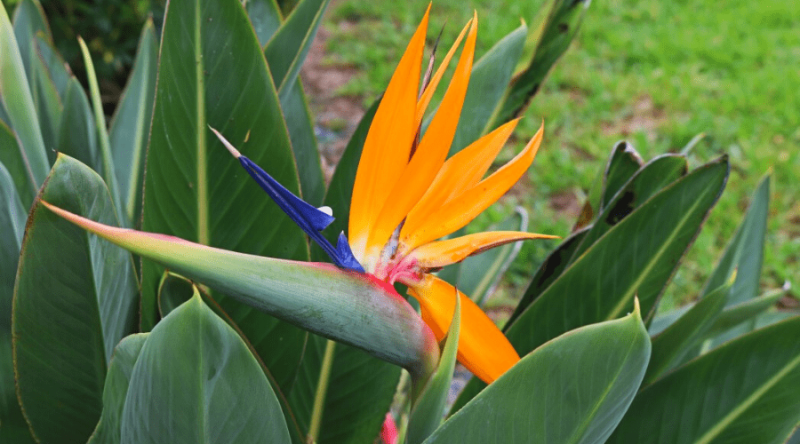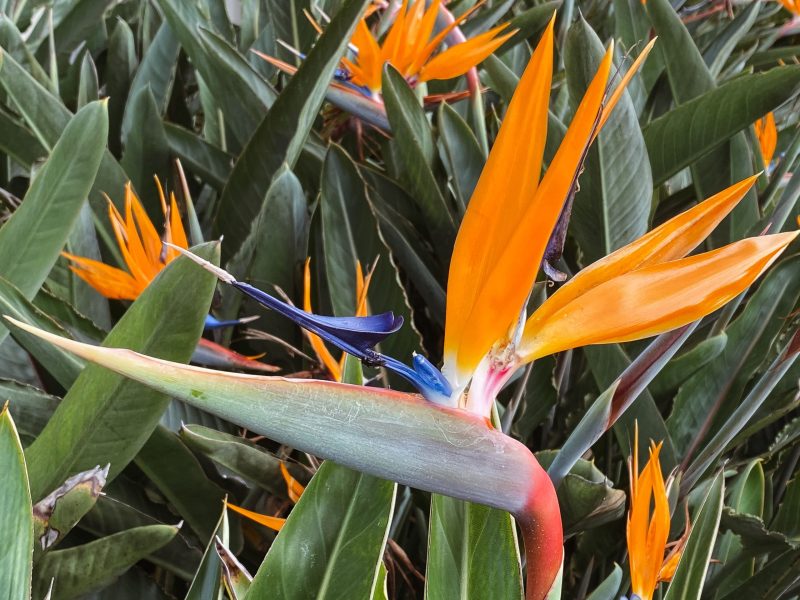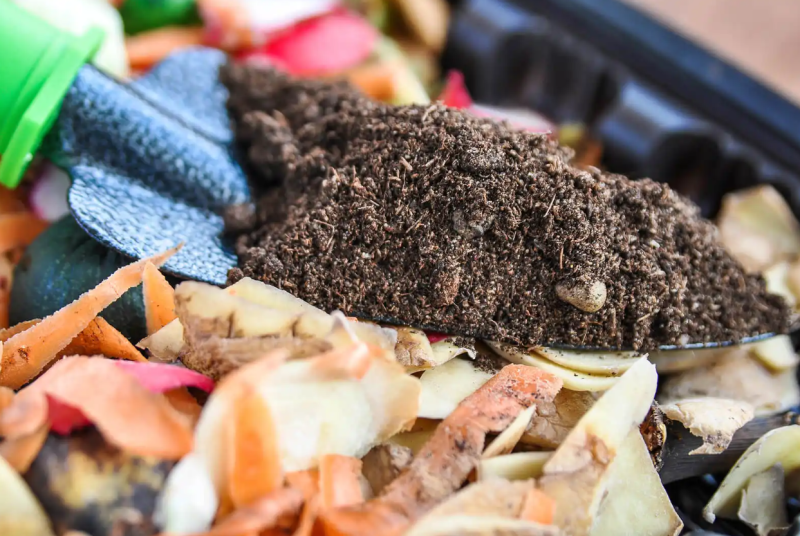
Bird of Paradise is the popular name by which the species Strelitzia reginae is known. Its name comes from the Latin reginae, which means ‘queen.’ It is a plant that stands out as a beautiful exotic flower in orange, bluish and violet tones resembling a bird’s head.
It is native to South Africa and has spread to various areas as it adapts to tropical and subtropical climates. It is popular in Colombia, Costa Rica, Mexico, Ecuador, Venezuela, Guatemala, and the Mediterranean coasts. It is one of the most popular tropical plants, along with orchids, heliconias, and anthuriums.
After being introduced to Britain in 1772, Sir Joseph Banks named the exotic plant Strelitzia after Queen Charlotte, Duchess of Mecklenburg-Strelitz, who was the wife of King George III. However, throughout the world, it is known through its popular name.
Contents
Characteristics of Bird of Paradise plants

The bird-of-paradise plant, also known as the bird flower, firebird plant, or crane flower, is an exotic plant of the Strelitziaceae family with limited commercial production. It has a long stem, from which leaves emerge with elongated pods that cover it with a bright green color.
It produces flowers throughout the year, although its flowering is more intense at the beginning of spring. Also, it has a long life. Because it originates from a tropical climate, it requires an optimum temperature close to 25 °C and a minimum of 10 °C. It also needs a humidity close to 70%. Under these conditions, it can reach a height of up to 2 meters.
At the end of its stem is a spike from which flowers emerge in a game of beautiful colors, formed with three reddish-orange sepals and some blue-purple petals. These are characterized because they stay fresh for an extended period. Its average duration is two weeks; however, they can keep their colors bright for up to 18 days.
Experts point out that the plant is essential in the international flower trade. Unlike lilies, they do not usually emit foul odors in vases, makings them highly desired for ornamentation. With their beauty, they give an exotic and tropical touch to environments.Other plants of the family Strelitziaceae and similar
Other plants of the Strelitziaceae family are also known under the name “bird of paradise plant,” which can lead to confusion. For example, Strelitzia alba is known as the white bird of paradise, and Strelitzia nicolai is the giant bird of paradise. Although they belong to the same genus, the truth is that they are different plants.
On the other hand, other unrelated species overlap with the characteristics of Strelitzia reginae. The most particular cases are those of Erythrostemon gilliesii and Caesalpinia pulcherrima. The latter is also known as the Mexican bird of paradise.
Curiosities about Strelitzia reginae
The bird of paradise is characterized by having sweet nectar that attracts birds and insects, such as hummingbirds and butterflies. It is known to concentrate a significant amount of glucose, fructose, and sucrose; however, the proportion varies according to the flowering time. On the other hand, the plant’s flowers are not pollen producers.
Due to its commercial value, attempts have been made to accelerate its development and seedling production through in vitro propagation techniques. Remember that the time from when the plant is planted to when a flower emerges can be significantly extended, depending on temperature and humidity.
A work published in the South African Journal of Botany states that the particular floral traits of Strelitzia reginae are not accidental. The researchers postulate that the convoluted petals covering S. reginae work to reduce nectar theft, though they caution that they are more effective against nectar thieves (such as sunbirds) than insects.
Bird of paradise plant care
The bird of paradise plant is hardy. Therefore, it works well in coastal areas with strong winds. However, it requires special care to keep it healthy and grow optimistically. If you want it at home, pay attention to the following points.
1. Allow it to receive sunlight
The Strelitzia reginae, a tropical plant, must receive sunlight for at least 4 hours daily. However, it would be best to have shade in the hottest months.
If you live in a place with severe frost in the morning or the temperature drops below 10 degrees Celsius, it is better to keep it indoors.
2. Plant it in a suitable soil
An investigation carried out by the Academic Unit of Agriculture of the Autonomous University of Nayarit found that the bird of paradise plants that are harvested in soils with a moderately acidic pH and rich in calcium, magnesium, and potassium grow with a more significant number of flowers and are They keep longer in the vase.
Therefore, you must guarantee excellent soil at home, which offers your flowers these minerals. Likewise, it requires good drainage to avoid waterlogging.
3. Prune regularly
The bird of paradise does not require excessive pruning. However, it is valuable that when the flower withers, cuts are made that eliminate the dead, brown, or withered parts to help it regenerate.
4. Choose the right pot size
The bird of paradise can be planted in a pot. It has solid roots and accelerated growth. Therefore, it is necessary to transplant it once every year.
You must ensure that it is a large pot size, which allows it to develop well. On the other hand, as long as it has the right temperature conditions, it can be placed indoors and outdoors.
5. Fertilize frequently
 The bird of paradise responds well to fertilizers with manure or home compost. You must do it every 20 days, as it is a plant that appreciates organic matter very well.
The bird of paradise responds well to fertilizers with manure or home compost. You must do it every 20 days, as it is a plant that appreciates organic matter very well.
6. Water it carefully
One of the most common mistakes that weaken or kill your bird of paradise plant is overwatering it. This causes their roots to rot.
You must keep the soil moist evenly and ensure puddles do not form. In the winter, you can water it two times a week, while in summer, you should do it four times a week.
Tips for the reproduction of the Bird of Paradise plant
When buying a bird of paradise plant, it is recommended to purchase cuttings or seedlings already developed because if you buy the seeds, you will have to wait a long time for them to grow and give flowers. Once you have it adapted to your home or garden, you will surely want to reproduce it to give it as a gift.
This plant can reproduce by two methods: sexual and asexual. That is to say, it is done through seeds or with the division of children or sprouts born from the mother plant.
Multiplication can also proceed from the tissue of small parts, known as “explants.” However, the simplest and fastest technique is division. Let’s see how to reproduce it in the most common ways.
By plant division
To divide the plant, remove it from the pot, not damaging the roots. For that, you can use a spatula as an aid.
- Carefully separate the plant with your hands, paying attention to the part where it divides naturally. To identify it, be guided by those buds that form on the sides of the main stem of the trunk.
- Next, you must untangle the roots. In the process, be careful not to damage them excessively. Use a knife to help you and make cuts that do not separate them from the stems. The young of the plant usually develop apart from the mother, so this process is not usually so complicated.
Through its seeds
The seeds found in this flower are usually a bit hidden. To find them, you should look for a light green bump that forms on the stem.
- Explore each of your flowers until you find them. It is a pod that is full of seeds. However, after identifying it, you must wait until it opens naturally.
- When it opens, you can find several black seeds surrounded by an orange layer. Please remove them and let them dry for about five days.
- Then, you should plant about three seeds in a pot with fertilized soil and good drainage. Water them sparingly and let the sun reach them. Between 3 and 4 months later, you can see the buds of the beautiful bird of paradise.
However, this process requires a lot of patience since not all seeds thrive in the ground. Also, its growth can take several years. On average, the plant will not flower this way for three to five years.
Final considerations
The plant generally does very well indoors, partly because you can control variables such as humidity or sun exposure. Its care and maintenance, compared to other plants, is deficient. Peak bloom occurs during winter and early spring, though you can enjoy this several times a year.